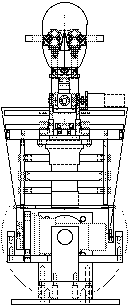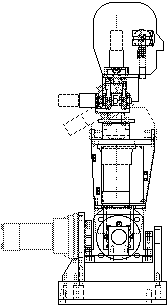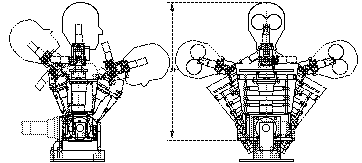Cog's Torso |
||||||||||||||||||||||||||||||
| Cog'sTorso MIT Artificial Intelligence Laboratory 545 Technology Square, #920 Cambridge, MA 02139 |
Cog's Torso
Design CriteriaTwo fundamental goals guided the design of the body for Cog. First, the robot should be anthropomorphic to encourage humans to interact with it in a natural way. The most important human characteristics to emulate are size, speed, and range of motion. To achieve natural human interactions, we felt it would be better to build a robot with modest load-carrying capacity but human-like speed. Second, the robot's hardware should use well-known technology and components to minimize design and construction time. Range of MotionCog's torso has six degrees of freedom: the waist bends side-to-side and front-to-back, the "spine" can twist, and the neck tilts side-to-side, front-to-back, and twists left-to-right. Mechanical stops on the body and neck give a human-like range of motion, as shown below (Not shown are the neck twist (180 degrees) and body twist (120 degrees)).
Cog resembles a human from the waist up. The robot is mounted on a pedestal to simplify design, construction, and power-efficiency problems. By placing power supplies and electronics in the base, it is easier to fit the robot in a human-sized torso and provide ample power to the electronics and motors. Power and SpeedTable 1 (shown below) summarizes the actuator requirements for the six degrees of freedom. The torque requirements were based on targets of a 5 lb head, 10 lb arms, and a 30 lb torso. The motors and mechanical components for the head weigh 3 lb, and for the body weigh 24 lb. Electronics and wires consume the rest of the weight allowance. The actuators in the robot are all DC gearmotors equipped with optical encoders for position sensing.
Body SensorsThe robot has sensors on its body. Each degree of freedom has current sensing in the motor controller to provide some force feedback. We avoided strain gages and other more sophisticated force sensors because of the accelerated construction schedule. There is also a temperature sensor on each motor and driver circuit. These sensors can warn the robot when a motor is being overworked. In the future this may be used to implement a "fatigue" sense. There are also currently plans to implement a "skin" of touch sensors for Cog.
|
|||||||||||||||||||||||||||||
Representatives of the press who are interested in acquiring further information about the Cog project should contact Elizabeth Thomson, thomson@mit.edu, from the MIT News Office, http://web.mit.edu/newsoffice/www/ . |
||||||||||||||||||||||||||||||


